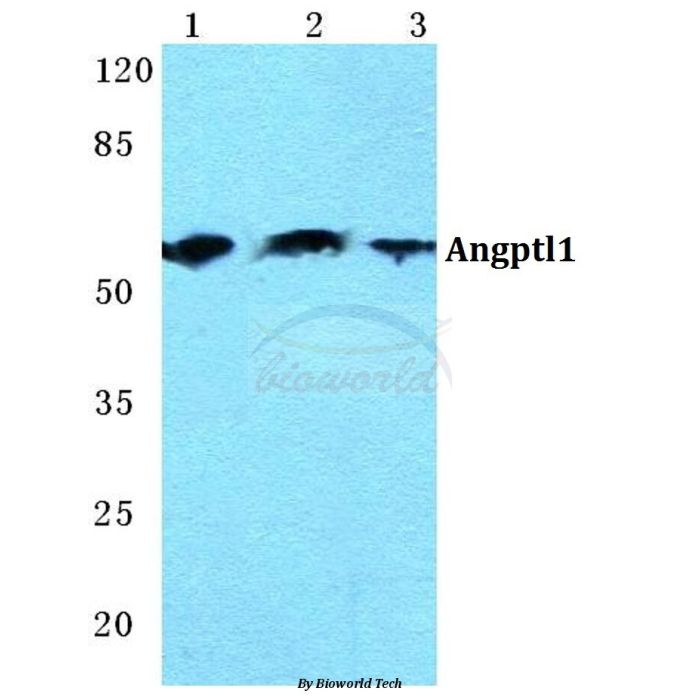Angptl1 polyclonal, anti-human, mouse, rat
€305.00
In stock
SKU
BS5611
Background:
Angptl1 (angiopoietin-like 1), also known as angioarrestin, ARP1, ANGPT3 or previously known as angiopoietin 3 (ANG3), is a member of the angiopoietin-like family. It is highly expressed in adult tissues, particularly adrenal gland, thyroid, placenta and small intestine. Angptl1 exists as a disulfide-linked dimer and shares 45.1% identity with Ang-1 and 59% identity with Angptl2. Angptl1 consists of an N-terminus with a coiled-coil domain, potential glycosylation sites and a C-terminus with a fibrinogen-like domain. It is a secreted protein but does not function as a growth factor in endothelial cells. Angptl1 plays a distinct role in the regulation of angiogenesis; inhibiting proliferation, migration, tube formation and endothelial cell adhesion. To exert this inhibitory activity, Angptl1 is speculated to interact with a receptor on endothelial cells. In a wide variety of tumor tissues, Angptl1 expression is down-regulated suggesting that a major function of this protein involves its antiangiogenic properties.
Alternative Name:
Angiopoietin-related protein 1, Angiopoietin-3, ANG-3, Angiopoietin-like protein 1, ANGPTL1, ANG3, ANGPT3, ARP1, PSEC0154, UNQ162/PRO188
Application Dilution: WB: 1:500~1:1000, IHC: 1:50~1:200
Specificity: Angptl1 polyclonal antibody detects endogenous levels of Angptl1 protein.
Immunogen:
Synthetic peptide, corresponding to amino acids 58-103 of Human Angptl1.
MW: ~ 56 kDa
Swis Prot.: O95841
Purification & Purity:
The antibody was affinity-purified from rabbit antiserum by affinity-chromatography using epitope-specific immunogen and the purity is > 95% (by SDS-PAGE).
Format:
1 mg/ml in Phosphate buffered saline (PBS) with 0.05% sodium azide, approx. pH 7.2.
Storage:
Store at 4°C short term. Aliquot and store at -20°C long term. Avoid freeze-thaw cycles.
For research use only, not for use in diagnostic procedure.
Angptl1 (angiopoietin-like 1), also known as angioarrestin, ARP1, ANGPT3 or previously known as angiopoietin 3 (ANG3), is a member of the angiopoietin-like family. It is highly expressed in adult tissues, particularly adrenal gland, thyroid, placenta and small intestine. Angptl1 exists as a disulfide-linked dimer and shares 45.1% identity with Ang-1 and 59% identity with Angptl2. Angptl1 consists of an N-terminus with a coiled-coil domain, potential glycosylation sites and a C-terminus with a fibrinogen-like domain. It is a secreted protein but does not function as a growth factor in endothelial cells. Angptl1 plays a distinct role in the regulation of angiogenesis; inhibiting proliferation, migration, tube formation and endothelial cell adhesion. To exert this inhibitory activity, Angptl1 is speculated to interact with a receptor on endothelial cells. In a wide variety of tumor tissues, Angptl1 expression is down-regulated suggesting that a major function of this protein involves its antiangiogenic properties.
Alternative Name:
Angiopoietin-related protein 1, Angiopoietin-3, ANG-3, Angiopoietin-like protein 1, ANGPTL1, ANG3, ANGPT3, ARP1, PSEC0154, UNQ162/PRO188
Application Dilution: WB: 1:500~1:1000, IHC: 1:50~1:200
Specificity: Angptl1 polyclonal antibody detects endogenous levels of Angptl1 protein.
Immunogen:
Synthetic peptide, corresponding to amino acids 58-103 of Human Angptl1.
MW: ~ 56 kDa
Swis Prot.: O95841
Purification & Purity:
The antibody was affinity-purified from rabbit antiserum by affinity-chromatography using epitope-specific immunogen and the purity is > 95% (by SDS-PAGE).
Format:
1 mg/ml in Phosphate buffered saline (PBS) with 0.05% sodium azide, approx. pH 7.2.
Storage:
Store at 4°C short term. Aliquot and store at -20°C long term. Avoid freeze-thaw cycles.
For research use only, not for use in diagnostic procedure.
| Is Featured? | No |
|---|
Write Your Own Review

